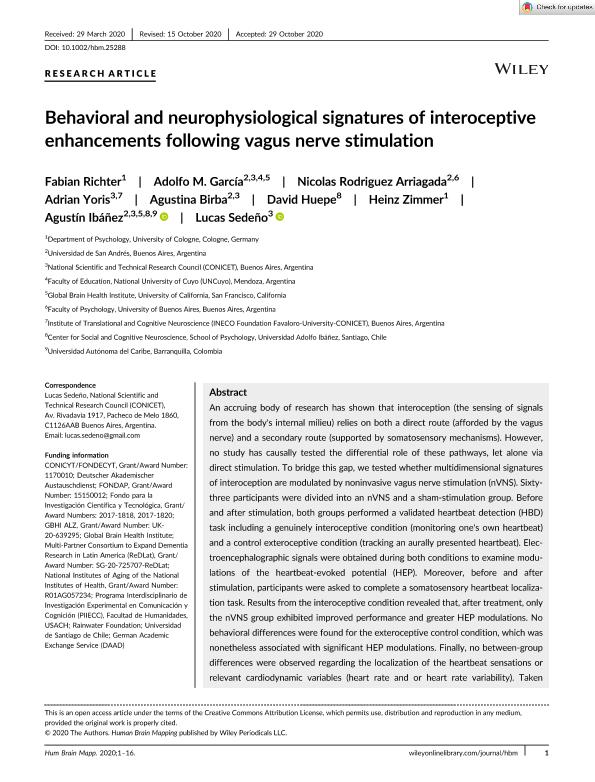Mostrar el registro sencillo del ítem
dc.contributor.author
Richter, Fabian
dc.contributor.author
García, Adolfo Martín

dc.contributor.author
Rodríguez Arriagada, Nicolás
dc.contributor.author
Yoris, Adrián Isidro

dc.contributor.author
Birba, Agustina

dc.contributor.author
Huepe, David
dc.contributor.author
Zimmer, Heinz
dc.contributor.author
Ibañez, Agustin Mariano

dc.contributor.author
Sedeño, Lucas

dc.date.available
2022-09-16T13:48:47Z
dc.date.issued
2020-10
dc.identifier.citation
Richter, Fabian; García, Adolfo Martín; Rodríguez Arriagada, Nicolás; Yoris, Adrián Isidro; Birba, Agustina; et al.; Behavioral and neurophysiological signatures of interoceptive enhancements following vagus nerve stimulation; Wiley-liss, div John Wiley & Sons Inc.; Human Brain Mapping; 42; 5; 10-2020; 1227-1242
dc.identifier.issn
1065-9471
dc.identifier.uri
http://hdl.handle.net/11336/169065
dc.description.abstract
An accruing body of research has shown that interoception (the sensing of signals from the body's internal milieu) relies on both a direct route (afforded by the vagus nerve) and a secondary route (supported by somatosensory mechanisms). However, no study has causally tested the differential role of these pathways, let alone via direct stimulation. To bridge this gap, we tested whether multidimensional signatures of interoception are modulated by noninvasive vagus nerve stimulation (nVNS). Sixty-three participants were divided into an nVNS and a sham-stimulation group. Before and after stimulation, both groups performed a validated heartbeat detection (HBD) task including a genuinely interoceptive condition (monitoring one's own heartbeat) and a control exteroceptive condition (tracking an aurally presented heartbeat). Electroencephalographic signals were obtained during both conditions to examine modulations of the heartbeat-evoked potential (HEP). Moreover, before and after stimulation, participants were asked to complete a somatosensory heartbeat localization task. Results from the interoceptive condition revealed that, after treatment, only the nVNS group exhibited improved performance and greater HEP modulations. No behavioral differences were found for the exteroceptive control condition, which was nonetheless associated with significant HEP modulations. Finally, no between-group differences were observed regarding the localization of the heartbeat sensations or relevant cardiodynamic variables (heart rate and or heart rate variability). Taken together, these results constitute unprecedented evidence that the vagus nerve plays a direct role in neurovisceral integration during interoception. This finding can constrain mechanistic models of the domain while informing a promising transdiagnostic agenda for interoceptive impairments across neuropsychiatric conditions.
dc.format
application/pdf
dc.language.iso
eng
dc.publisher
Wiley-liss, div John Wiley & Sons Inc.

dc.rights
info:eu-repo/semantics/openAccess
dc.rights.uri
https://creativecommons.org/licenses/by/2.5/ar/
dc.subject
HEARTBEAT DETECTION TASK
dc.subject
HEARTBEAT-EVOKED POTENTIAL
dc.subject
INTEROCEPTION
dc.subject
NEUROVISCERAL COMMUNICATION
dc.subject
NONINVASIVE VAGUS NERVE STIMULATION
dc.subject.classification
Psicología

dc.subject.classification
Psicología

dc.subject.classification
CIENCIAS SOCIALES

dc.title
Behavioral and neurophysiological signatures of interoceptive enhancements following vagus nerve stimulation
dc.type
info:eu-repo/semantics/article
dc.type
info:ar-repo/semantics/artículo
dc.type
info:eu-repo/semantics/publishedVersion
dc.date.updated
2022-09-15T14:54:11Z
dc.journal.volume
42
dc.journal.number
5
dc.journal.pagination
1227-1242
dc.journal.pais
Estados Unidos

dc.journal.ciudad
New York
dc.description.fil
Fil: Richter, Fabian. Universitat zu Köln; Alemania
dc.description.fil
Fil: García, Adolfo Martín. Universidad Nacional de Cuyo. Facultad de Educación Elemental y Especial; Argentina. Consejo Nacional de Investigaciones Científicas y Técnicas; Argentina. Universidad de San Andrés; Argentina
dc.description.fil
Fil: Rodríguez Arriagada, Nicolás. Universidad de San Andrés; Argentina. Universidad de Buenos Aires; Argentina
dc.description.fil
Fil: Yoris, Adrián Isidro. Consejo Nacional de Investigaciones Científicas y Técnicas. Oficina de Coordinación Administrativa Houssay. Instituto de Neurociencia Cognitiva. Fundación Favaloro. Instituto de Neurociencia Cognitiva; Argentina
dc.description.fil
Fil: Birba, Agustina. Consejo Nacional de Investigaciones Científicas y Técnicas; Argentina. Universidad de San Andrés; Argentina
dc.description.fil
Fil: Huepe, David. Universidad Adolfo Ibañez; Chile
dc.description.fil
Fil: Zimmer, Heinz. Universitat zu Köln; Alemania
dc.description.fil
Fil: Ibañez, Agustin Mariano. Universidad de San Andrés; Argentina. University of California; Estados Unidos. Universidad Adolfo Ibañez; Chile. Consejo Nacional de Investigaciones Científicas y Técnicas; Argentina
dc.description.fil
Fil: Sedeño, Lucas. Consejo Nacional de Investigaciones Científicas y Técnicas; Argentina
dc.journal.title
Human Brain Mapping

dc.relation.alternativeid
info:eu-repo/semantics/altIdentifier/url/https://onlinelibrary.wiley.com/doi/full/10.1002/hbm.25288?af=R
dc.relation.alternativeid
info:eu-repo/semantics/altIdentifier/doi/https://doi.org/10.1002/hbm.25288
Archivos asociados
